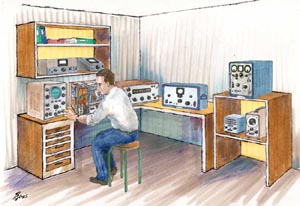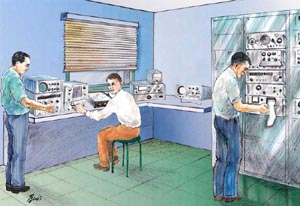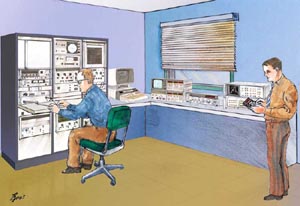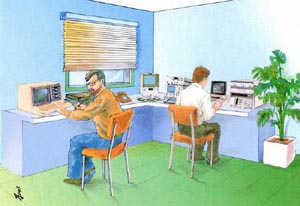

3 - Exhibiting 60 years of Science and Technology contributions






Drawings by Christian BUIS
A Show Place: Why, What & How?
WHY: Because the Hewlett Packard Success Story is a story worth telling, and a story worth understanding.
WHAT: It deserves a place to honor and remember the individual innovative contributions that built this organization, and a way to share them.
A proud home befitting the quality of the collection. Allowing students, scientists and passionate fans, access to an unparalleled portfolio of inventions and innovations made by HP during the last 70 years.
HOW: By taking advantage of the first 15 years of work on the HP Memory Project,
The combination of all the elements listed in the previous chapter prove that the HP Memory Project is one of the most historically significant HP archives remaining, of both physical hardware and substantial quantities of documentation. However, the project is not just a collection. It is also an ambitious work focused on the preservation of the history of a company which focused on innovation.
How could these resources be better utilized in a more relevant place? Such an exhibition could be constructed in many different ways. This chapter, will develop some of our thoughts on trying to accomplish that objective.
Concept
From the beginning of this project, we have always thought that if such a place were to be built, it must not be seen as a Museum with antiques on pedestals, but as a showroom displaying Progress and the methods HP used to create state of the art technology.
The showplace is imagined as a walk through time. Travelling from engineering “bench” to “bench” witnessing progress in technology, with the flavor of changing times and styles. Each exhibit would be fitted with working instrumentation highlighting the best available technology along with period furnishings and accessories.
A very simplified illustration of this concept is shown in the animation above.
Between the booths, information relative to the "scene" will be offered to the visitor through their choice of presentation media (to be discussed later). Many variations of visitor assistance are envisaged, from the simplest information panel, to the most sophisticated interactive technologies, and even volunteer-manned displays. As well, many different types of information can be delivered through this media:
- Variable detail in technical description of important products and technology (from original documents, HP-Journal, App. Notes etc...)
- Innovation brought about by a specific product
- Impact of the innovation on the technology and engineering at large
- Designer's original notes relative to the products from their own writing. Many such writings have already been collected and published on the HP Memory Website. Accurate and meaningful information can't have a better source than the original designer.
In Practice:
Six booths would be a minimum, thus dividing the overall story into approximately six decades. A minimum length of 13 feet for each booth, and 7 feet between them would be necessary.
The booths could be arranged in different ways depending on the space available, and the shape of the room which will host the full exhibition. Three main kinds of arrangements could be envisaged:
- Linear, for a total length of approximately 100 feet, and a required floor space of 3500 square feet.
- In a "U" shape. For a total floor space of approximately 5300 square feet.
- In a semi-circle shape. For at least 7500 square feet.
The in line option would create a long showcase to look at, while walking along a long wall. The "U" and semi-circle shapes would be a choice also, giving a panoramic overview of the full timeline at first glance, but would increase the overall needed space.
Inside each booth, individual pieces of equipment on display could be temporarily enhanced by a small floodlight while details about the product would be available to the visitor by a recorded audio, and/or video message.
 |
Another possible approach would be to give the visitor control of the available information via a control screen facing the booth. Dedicated Web pages accessed from these control screens will give a choice of informational items as discussed in the Concept chapter above. As a guide, we refer to some displays at the Computer History Museum, which use active video signage, allowing static messages as well as supporting video.
It is important to note that a large part of this work has already been done during the construction of the HP Memory Website. Most of the necessary products have already been photographed, and original documents have been scanned. Even some existing animations could be used as-is, to improve the quality of the information available. Some examples below:
In a real installation, it would be easy to have it fully automated using Hewlett-Packard equipment and Agilent VEE Pro software controlling already available HP automation hardware.
A short-form, non-exhaustive, listing of the key products and related technologies to be exhibited and demonstrated can be seen in the tables below. The tables have been constructed according to the suggested six decade timeline. All products listed are included in the HP Memory collection, excepted those marked with (*)
More on Demand
Basically, Hewlett Packard's achievements can be exhibited in any place where the illustration of technology growth is the objective. The HP Memory Project could deliver everything necessary for a Hewlett Packard display in such an exhibition.
Hosting and maintaining the project described above would require considerable funding. Hopefully, if a project with this level of sophistication could find sponsors, there would be no limit to the variety of configurations which could utilize the currently available resources.
The main objective of this presentation was to present a review of all available resources that the HP Memory Project has collected during its first 15 years of activity, and to suggest possible future evolution. Additionally, this presentation hopes to raise awareness among interested parties, and we will be glad to deliver more information to any request coming from any serious organization who could become active partners in the project, and who would be willing to benefit from the work already done.
Please use the contact us form below:













